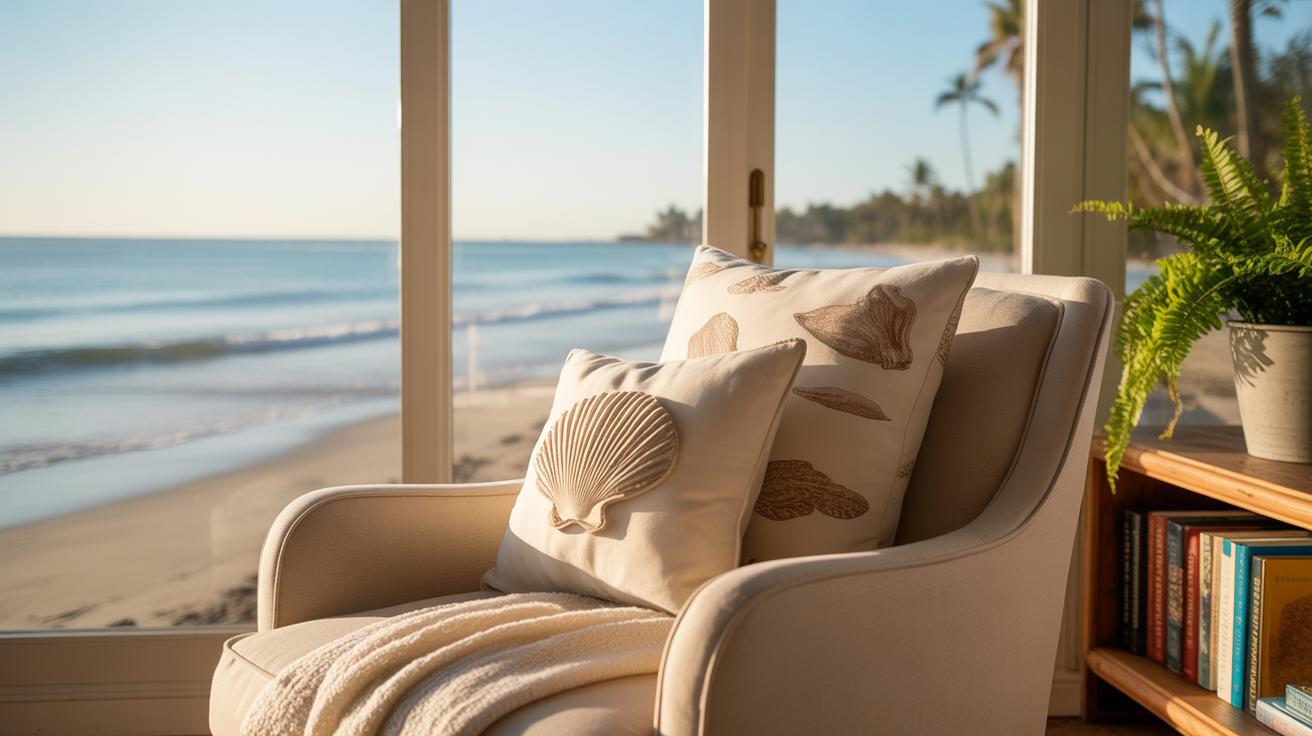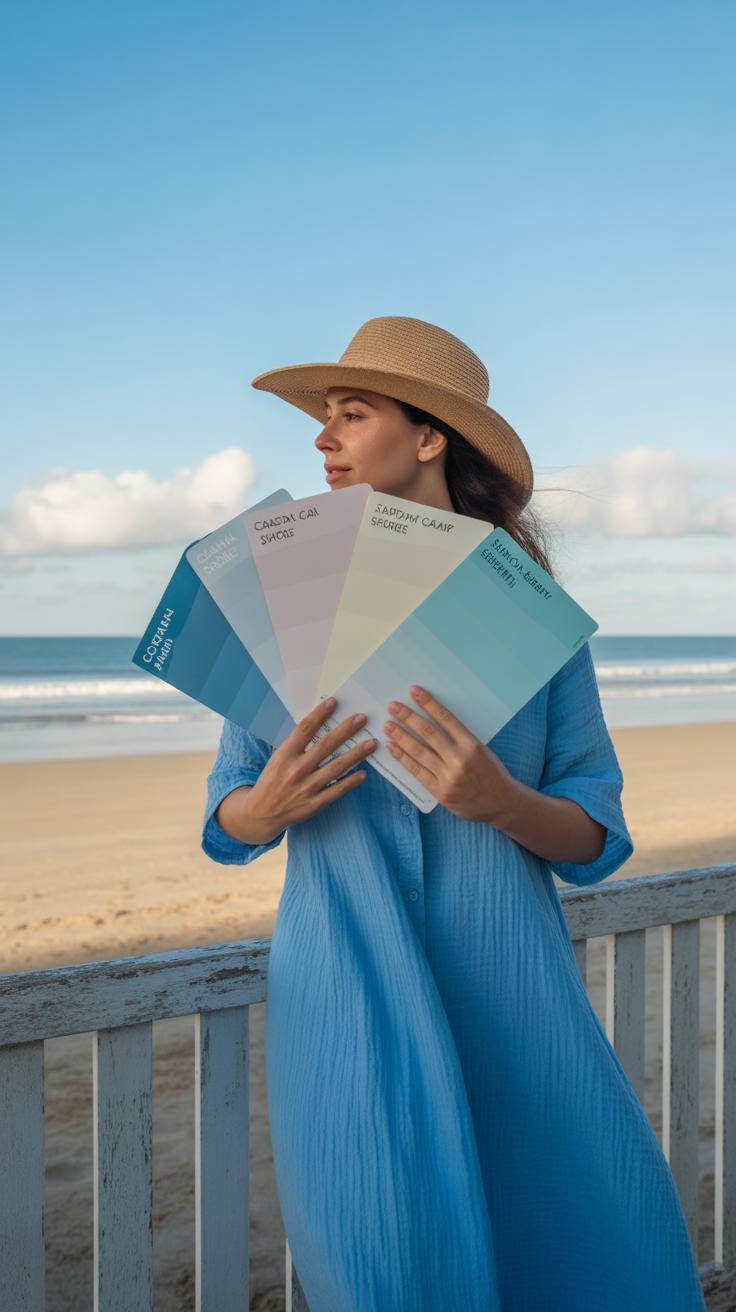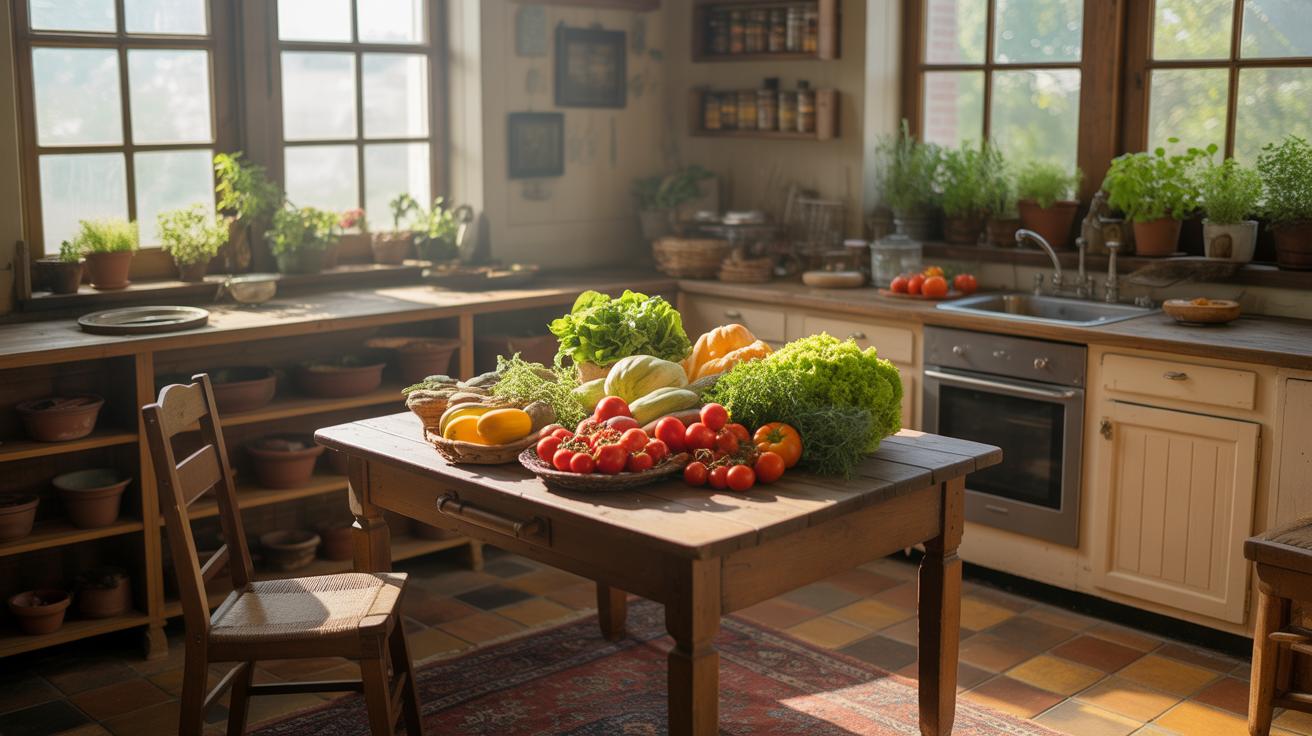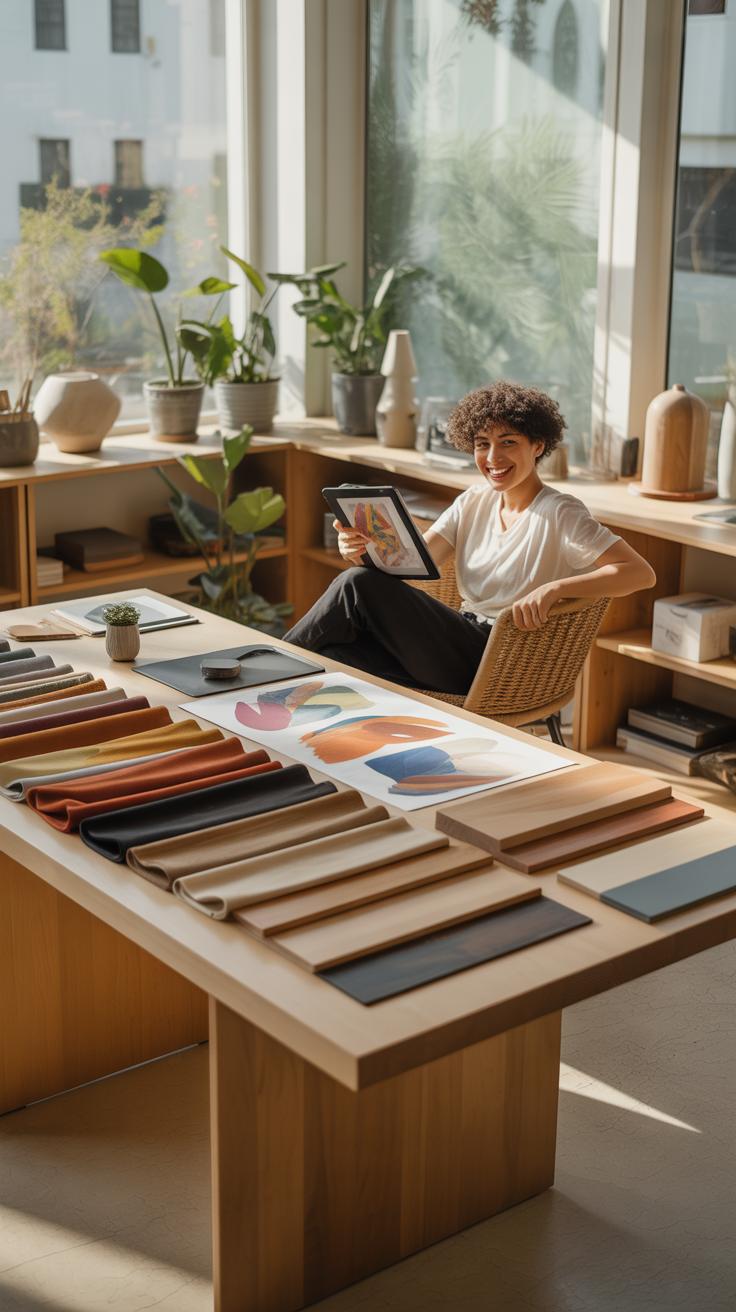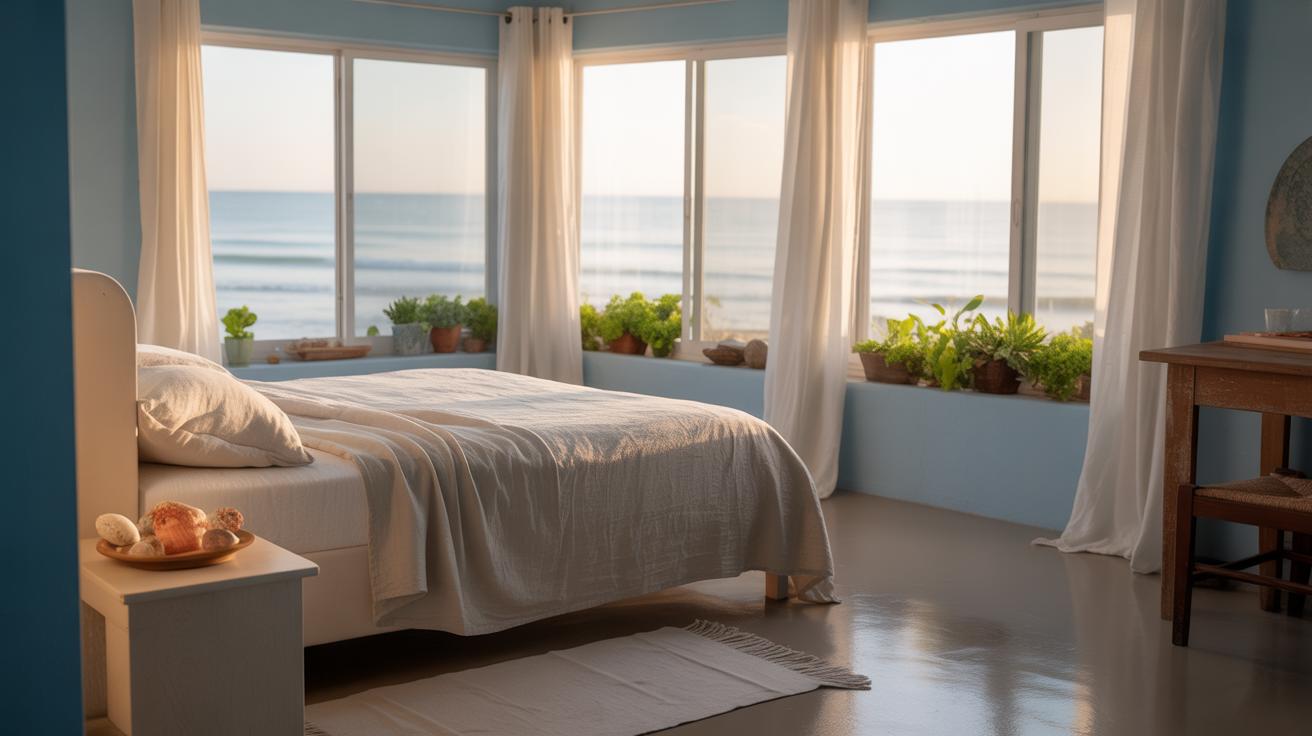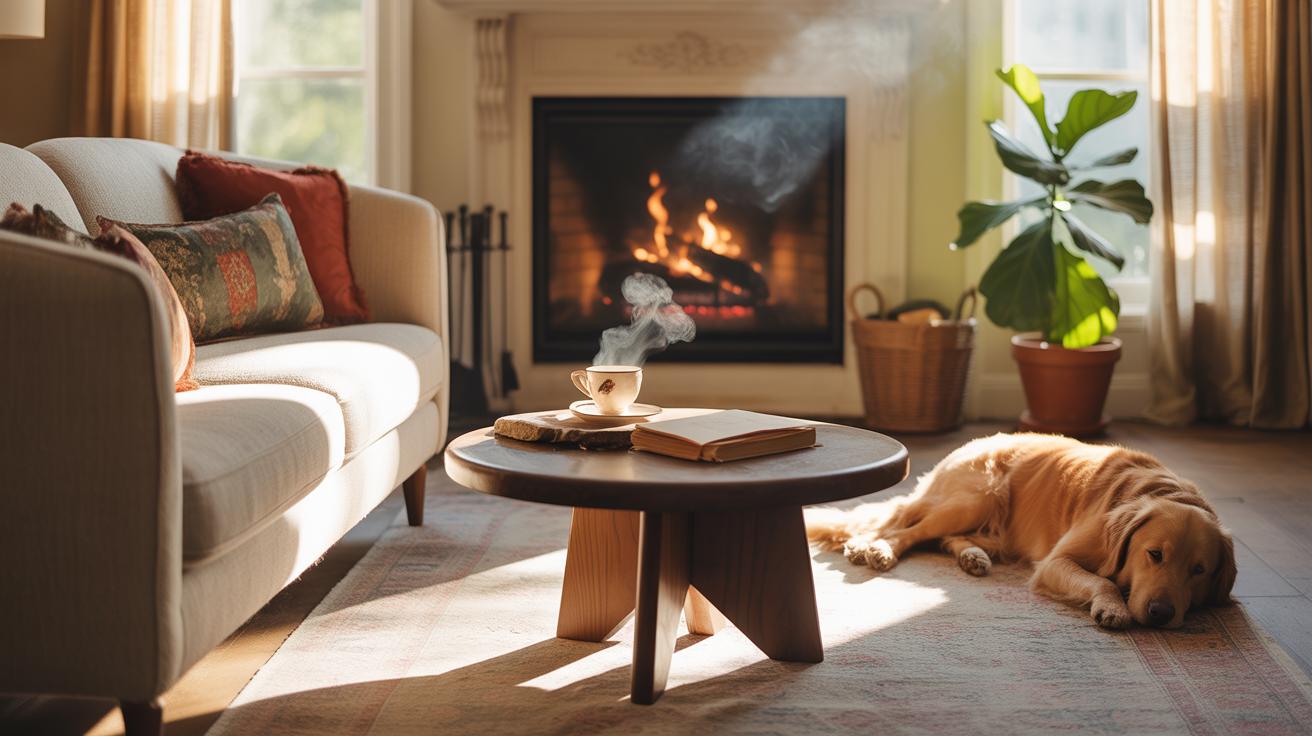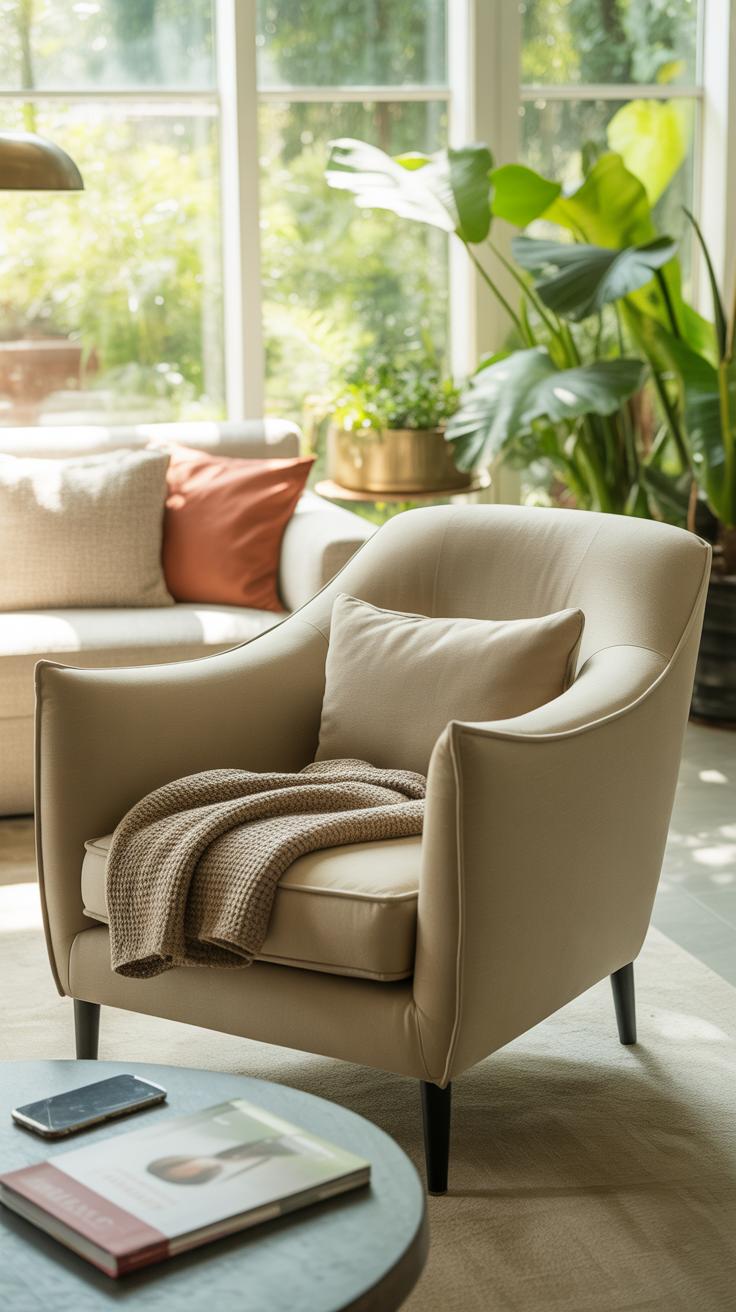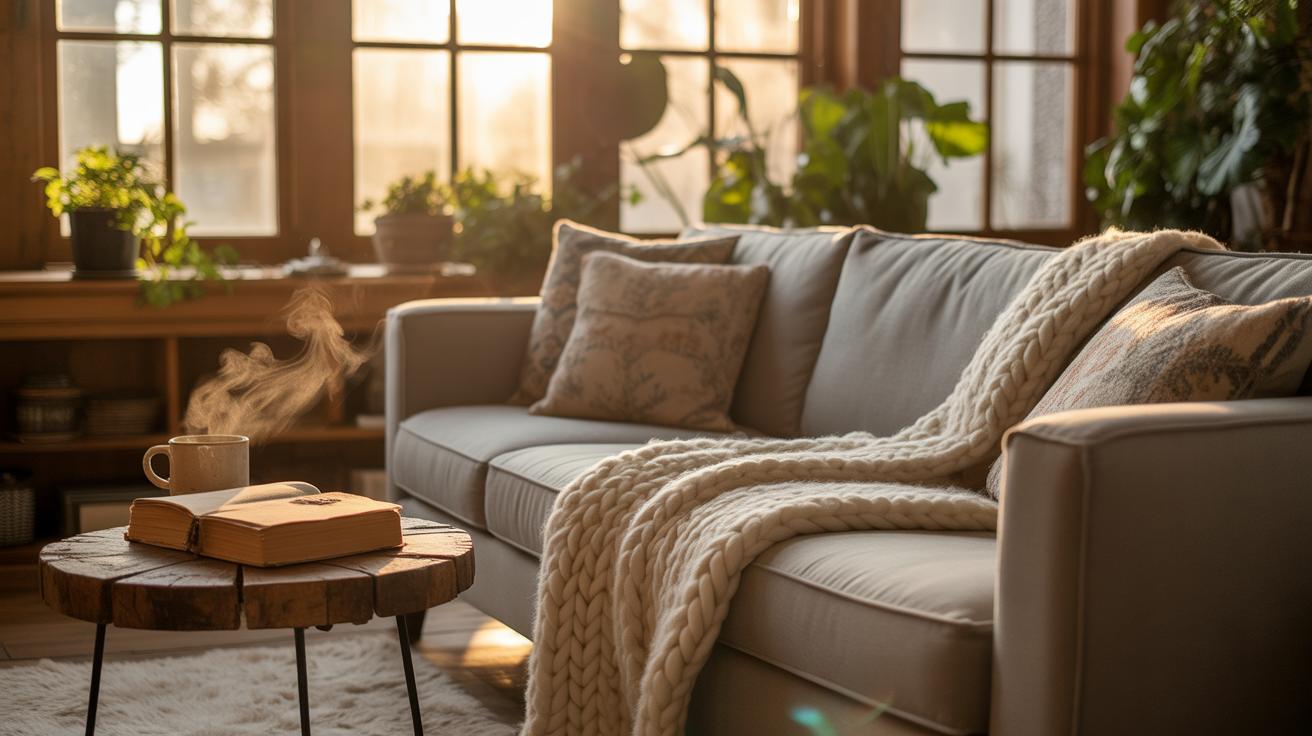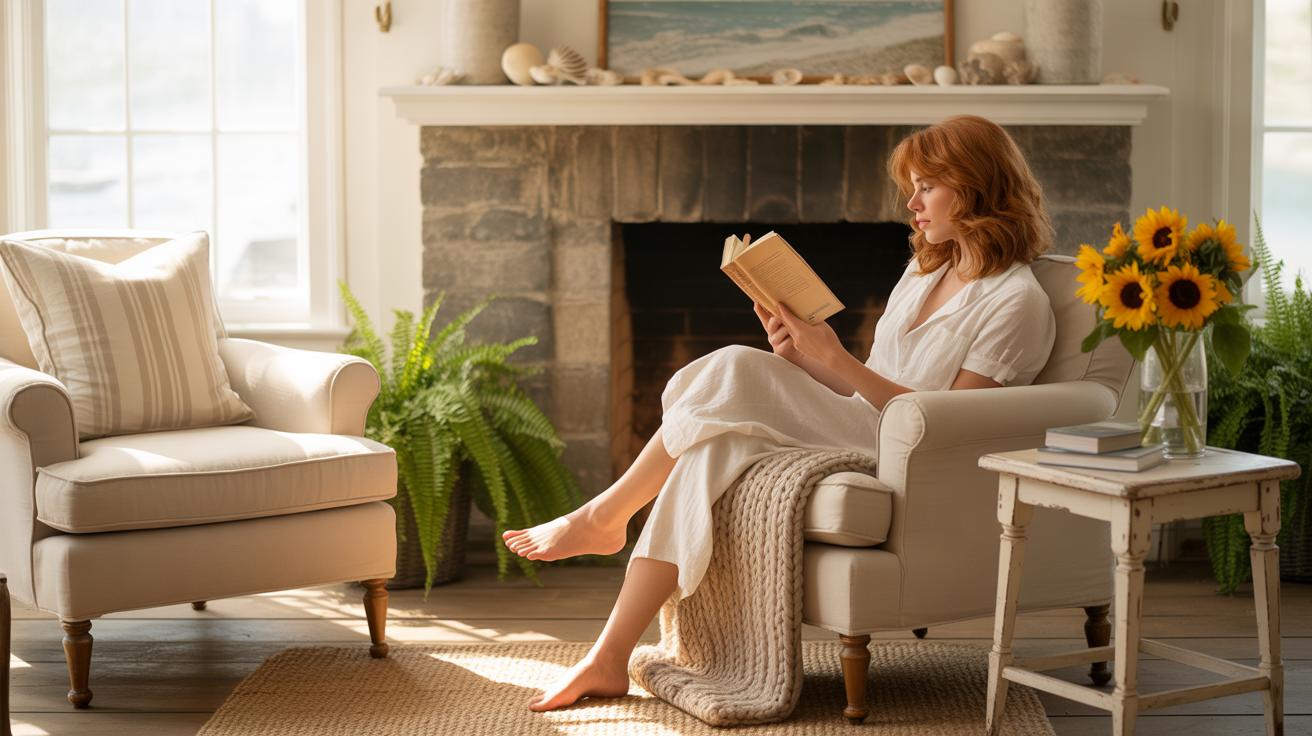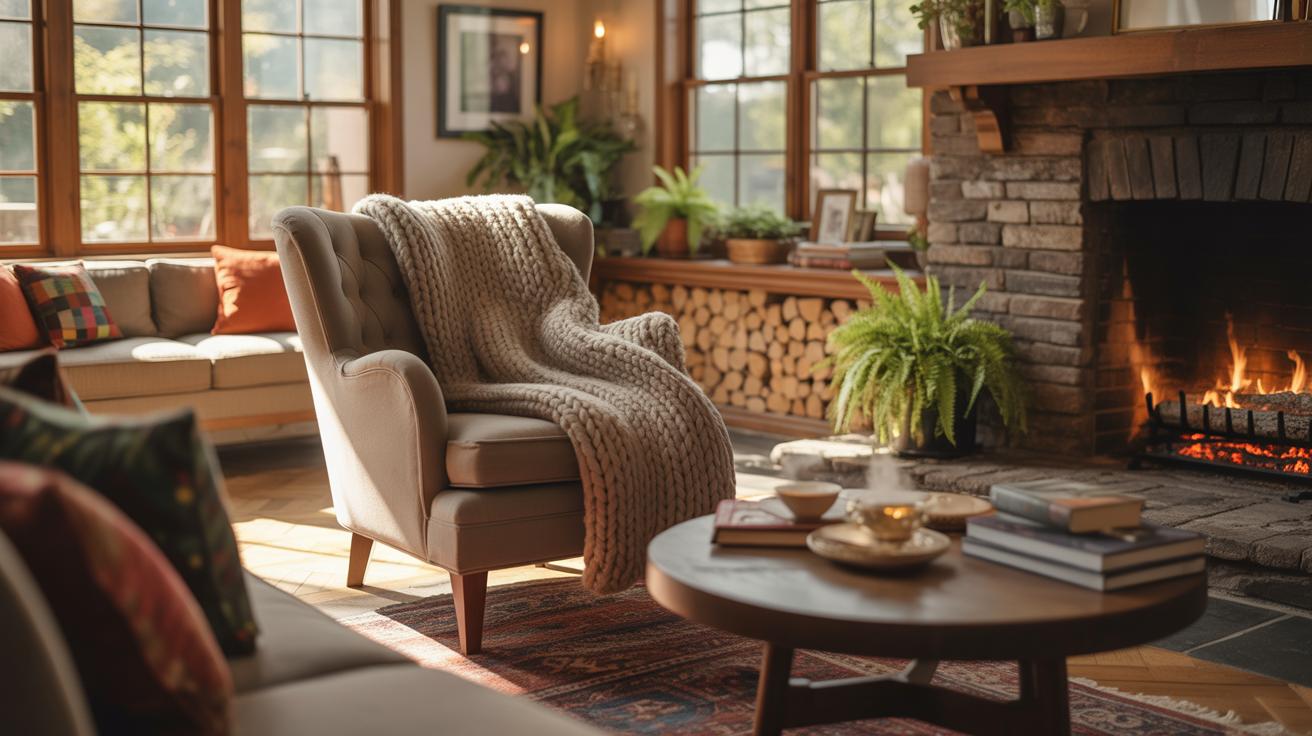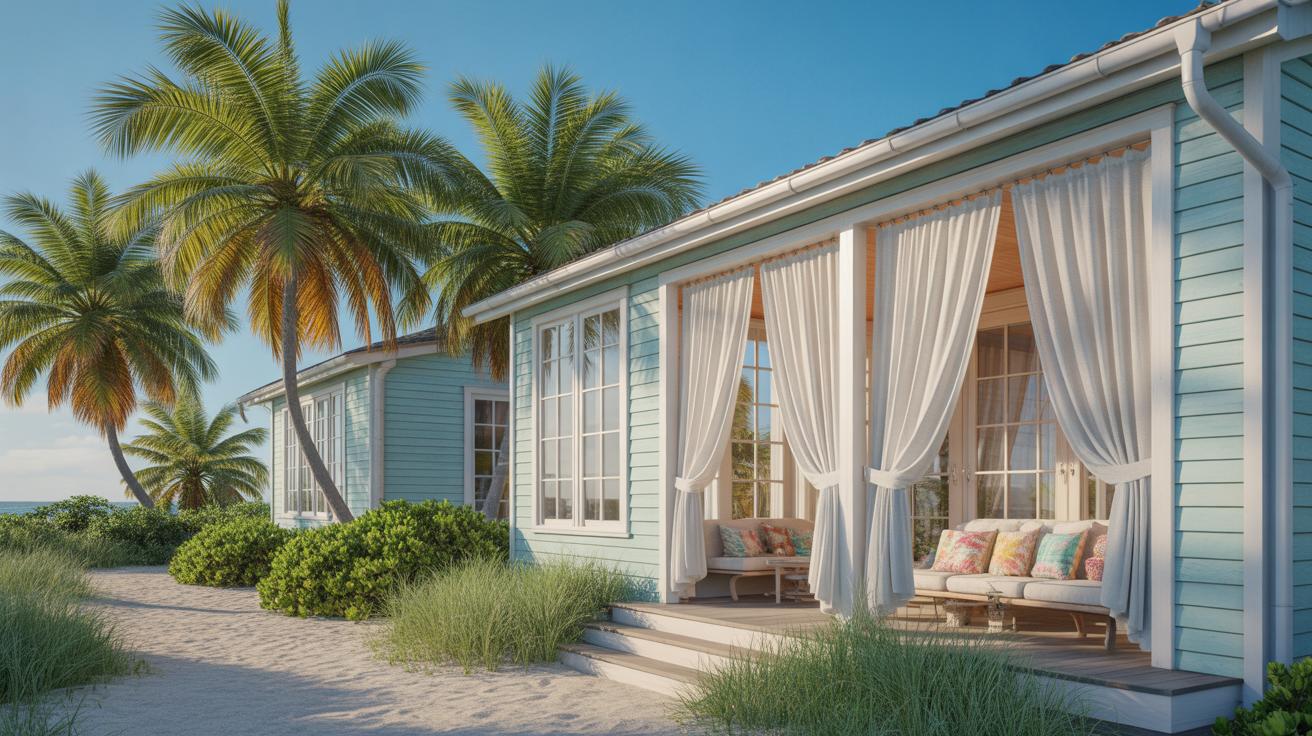Introduction
Creating a coastal room can bring the relaxing feel of the beach right into your home. This article explores easy ways to design your perfect beachy space. We will look at colors, furniture, decorations, and lighting that remind you of the ocean and sand.
You will learn to transform your room with simple ideas that anyone can do. Whether you live by the sea or far away, these tips will help bring a fresh, calm look to your living space. Let’s dive into the best coastal room ideas to make your home feel like a beach getaway.
Choosing Coastal Colors
Colors shape the feel of your coastal room more than you might expect. When you think about the beach, certain hues come to mind naturally—blues, whites, and soft sandy tones. These colors aren’t just pretty; they set a mood that almost pulls the ocean air inside. Blues remind us of the water’s vastness, whites mimic the sunlit foam of waves, and sandy colors echo the shore beneath your feet.
Picking these colors carefully can make your space feel relaxing without being dull. It’s a delicate balance, really. You want your room to suggest the beach’s refreshing calm without becoming a cliché or overwhelming your senses. Do you want the colors to energize you or soothe you at the end of the day? Thinking about that helps a lot when choosing shades.
Blue Shades for Calmness
Blues carry a calmness that’s hard to replicate with any other color. Sky blue can open up a room, making it feel larger and lighter, like you’re under an endless expanse of sky. Turquoise brings in a bit of playfulness, mixing green with blue to evoke tropical waters. Both shades pull the ocean vibe indoors but in subtly different ways. Maybe sky blue suits a bedroom where you want to unwind, while turquoise fits a lively living space or a bright bathroom. These blues don’t shout—they invite you to sit down and pause for a moment. Experimenting with various intensities can help you find what suits your personality and the light in your room.
Whites and Neutrals
White walls often get overlooked as just a backdrop, but they do a lot more. They reflect natural light, making spaces feel clean and fresh, which is crucial when you’re trying to create that breezy, beachy impression. Neutral hues—think soft grays, beiges, or even pale taupes—work with whites to soften the starkness while still providing balance. They prevent the blues from feeling cold or overpowering. I’ve found that these neutrals can ground a room without stealing attention, allowing your coastal colors and textures to shine. How white or creamy you go may depend on the natural lighting in your space or how much warmth you want. You might surprise yourself by how a simple neutral can transform the mood.
Natural Materials Use
There’s something about natural materials—wood, jute, cotton—that makes a coastal room feel right. Maybe it’s because they bring a bit of the outdoors inside, grounding the space in the textures and colors of the beach itself. You probably notice how wood doesn’t just look warm but also has a subtle texture your eyes can rest on. From driftwood-style coffee tables to weathered wood beams or picture frames, that touch feels honest and welcoming.
Jute’s another one that often gets overlooked but works well. Think about a jute rug underfoot or woven baskets for storage—those fibers remind you of beach grass, simple and sturdy. Cotton and linen fabrics on your cushions or curtains add lightness, but also softness. They allow sunlight to filter through, giving the room that laid-back feel without being too stuffy or stiff.
Here’s a thought though: sometimes these materials can feel rough or unfinished, not perfectly smooth. But that might actually fit the coastal vibe better than anything too polished. Don’t rush to cover every surface; a little imperfection, a natural knot in the wood, a slightly uneven weave in the rug, can bring your room to life in a quiet way.
Wood for Warmth
Wood furniture or accents are an anchor in a beachy room. Whether it’s a walnut side table or a reclaimed pine dining set, wood adds texture and warmth that’s easy to appreciate. It breaks up the often pale color schemes with something tactile, a contrast you almost want to touch. Of course, lighter woods like oak or maple complement coastal colors nicely, but darker woods can work too if balanced well.
There’s a comfort in wood that synthetic materials rarely duplicate. It lends a sense of history or place, even if your furniture is brand new. It’s also versatile—wooden frames, shelves, and even small decor pieces can shape how cozy or rustic your room feels. I’ve noticed rooms with all painted furniture sometimes come across a little cold, whereas wood snaps you right back to something familiar and warm.
Textiles and Rugs
When picking textiles, cotton and linen are visitors you’ll want to keep around. Their breathability fits the relaxed feel of coastal spaces, and they wear well over time. For curtains, lightweight linen sheets can soften light gently, helping your room glow without blocking that beachy brightness. Cushions in cotton with subtle stripes or solids create gentle layers of comfort without feeling overdone.
Natural fiber rugs—like sisal, seagrass, or jute—tie the room together practically and visually. They add texture underfoot and keep things grounded in nature, but also handle sandy feet without wearing out quickly. Sometimes those rugs might not be perfectly uniform, and that’s what gives them character. Try layering a soft cotton throw over a jute rug for a combo that’s both durable and inviting.
So, while color choices set your room’s mood, these natural materials shape how you actually feel in the space. Does your room invite you to sit down and take a breath? Or do the textures push you away? That’s something to think about when you’re bringing nature indoors.
Furniture Selection
When choosing furniture for a coastal room, think light and simple—pieces that don’t weigh down your space. Light-colored sofas and chairs, such as those in soft beige, pale gray, or classic white, help keep the room feeling fresh and open. I remember swapping out my dark leather couch for a linen slipcovered one, and the whole room instantly felt airier. It’s almost like the furniture breathes with the room instead of dragging it down.
Look for clean lines instead of ornate or bulky designs. A pared-down style fits better with the beach vibe and doesn’t compete with natural textures like rattan or jute you’ve already brought in. But don’t sacrifice comfort—plush cushions or soft fabrics make all the difference when you want to relax after a day by the water.
Multi-use furniture is especially handy, particularly in smaller coastal rooms. Consider ottomans that open up for storage—perfect for blankets or beach towels. Folding tables or nesting side tables work well too, giving you flexibility without clutter. I think it’s easy to overlook function when caught up in style, but in a beachy space, versatile furniture really pays off. You might wonder, though, if simplicity ever risks feeling too sparse—but with the right textures and a bit of layering, it doesn’t have to.
Beachy Decorations
Small details often make the biggest difference when you want a room to feel truly coastal. Seashells and driftwood are classic choices, but they don’t have to feel predictable or overdone. For example, a simple bowl filled with mixed shells from a recent beach trip can sit on a coffee table or shelf, creating a casual, authentic vibe. Driftwood pieces can be arranged along a mantel or stacked neatly on an entryway table—sometimes their rough shapes and natural textures bring a surprising warmth and balance to lighter furniture.
When it comes to ocean art, finding the right piece matters more than selecting the biggest or most colorful print. A delicate watercolor of crashing waves might feel more calming than a bold, dramatic painting of a stormy sea. Coastal wildlife—like birds or crabs—can also add subtle life without overwhelming the space. It’s interesting how just a few framed prints, spaced thoughtfully, can shift the mood of a room toward something more relaxed and open.
Would you prefer art that’s literal, showing beaches clearly, or something more abstract that hints at the coast? Both have their place, depending on the atmosphere you want. And while shells and driftwood might sound simple, mixing their textures with fabric or ceramics can create layers that feel, well, lived-in, not just staged. At least, that’s how I’ve found them to work best.
Lighting for Atmosphere
Creating a coastal room that feels like you’re watching a sunset by the shore means paying close attention to lighting. Think about how natural light fades softly as evening comes, casting a warm, golden glow. To capture that, it helps to let sunlight flow in freely during the day. Large windows are a great choice because they open the room to the outside world and fill it with brightness. If privacy or glare is a worry, sheer or light, airy curtains can soften the sunlight without blocking it out entirely. They gently diffuse the light, making the whole space feel calm and open—almost like the light is wrapping around you.
Artificial lighting plays a big role after dusk. Lamps with bulbs that give off a warm, tinted glow (not bright white or cool blues) help keep the mood mellow. And the fixtures themselves? Choosing materials like rattan, rope, or driftwood designs adds texture that feels very natural. Think about a woven lamp shade or a lamp base braided in rope—these details connect you to the beach vibe without obvious kitsch. I’ve found that mixing a low-watt soft bulb with these natural textures makes the light feel layered and cozy rather than harsh or sterile. Warm light invites you in, making the space comfortable for informal gatherings or quiet reading alike.
Would you try combining natural light and carefully chosen lamps to get that glowing atmosphere? It’s not just practical—it’s about creating a room that feels alive, like the light itself is part of the décor. Lighting is more than illumination; it’s part of what shapes how you experience that coastal space every time you walk in.
Incorporate Greenery
Adding plants to your coastal room can bring a surprising sense of freshness and life, making the space feel less like a static showcase and more like a lived-in retreat. You might find that plants soften the room’s edges and naturally connect indoor and outdoor vibes—though sometimes the choice of greenery feels tricky. Should you go for lush, tropical leaves or something more minimalist? I think either can work, depending on the mood you want.
Tropical Plants Choices
When aiming for that easy, beachy feel, low-maintenance tropical plants often do the trick. Palms, like the Kentia or Parlor Palm, are classic picks—they bring that tall, graceful shape without demanding much fuss. Succulents, on the other hand, offer a bit of contrast with their geometric forms and need even less care. Snake plants and monstera are also popular; they’re forgiving and add bold green shapes that remind you of far-off shores.
Placement Tips
Where you put your plants can make a big difference, though sometimes it’s worth experimenting a bit. Corners often welcome taller plants like palms; they fill empty space without overwhelming the room’s flow. Shelves work well for smaller succulents or trailing vines, adding layers without crowding the floor. Near windows, plants soak up light, which usually helps them thrive, but be mindful of your window’s exposure—too much sun can scorch some leaves. Maybe try placing a fern or two just inside a north-facing window for that shadier look.
Ultimately, plants don’t just decorate—they bring in that ever-changing edge of life, which I think is exactly what a coastal room needs to feel right.
Flooring Options
When it comes to coastal rooms, choosing the right floor can make all the difference, both in look and feel. Light wood floors often top the list—they instantly bring an airy, relaxed vibe that suits a beachy space. Think pale oak or whitewashed pine; these give the room a casual, sun-kissed impression without overwhelming the décor. Plus, wood is durable enough to handle what beach life throws at it—sand, occasional dampness, and all.
Neutral tiles can also work well, especially if you prefer a cooler, more practical option. Slate or soft beige tiles mimic sandy shores nicely and resist moisture better than wood. It’s interesting—tiles can sometimes feel less warm underfoot, but pairing them with the right rug can fix that.
Wood and Tile Floors
Light wood floors echo driftwood and sun-bleached planks, which naturally just fits the beach theme. They create a seamless flow throughout, making spaces feel open and breezy. Neutral tile floors have their place too, especially in spots like kitchens or entryways, where spills and dirt are more common.
Sometimes it’s tricky deciding between the two—you want the softness of wood but the practical edge of tile. Maybe a mix is the answer.
Rugs for Comfort
Natural fiber rugs, like sisal or jute, add a layer of texture and soften hardwood or tile floors nicely. They bring in an organic, grounded feel while staying true to coastal simplicity. These rugs can withstand wear, yet they’re not too fancy—perfect for a laid-back seaside look.
On the downside, they may feel a bit rough at first, especially if barefoot. Over time, though, they mellow out and pick up character, much like the rest of your coastal décor. Sometimes a larger rug in the living area plus smaller ones throughout can make the floor feel inviting without looking stiff.
Final Touches
Small details can make or break a coastal room. Think beyond the big pieces like furniture or flooring. Little things, like softly folded throws on a chair or a neat stack of sea-inspired books, bring the space to life. It’s often the careful, tidy arrangements that make the room feel welcoming without feeling cluttered. I’ve noticed that when everything has its place, the room somehow breathes better.
A clutter-free space doesn’t just look calmer; it feels calmer. The coastal style thrives on openness and simplicity. And that means cutting out excess. It’s tempting to hold onto every seashell or driftwood piece, but choosing a few favorites and displaying them thoughtfully is better—and less overwhelming.
Personal coastal finds give the room character. Photos from beach trips, shells collected at sunset, or an old beach map tucked into a frame can instantly add meaning. When I’ve visited friends with personal mementos around their beach-inspired rooms, it always felt richer, like stories were quietly told through objects. What stories could your souvenirs tell?
Conclusions
Designing a coastal room is about bringing elements from the beach into your daily life. Using soft sea colors, natural materials, and thoughtful decorations creates a room that feels open and calm. You don’t need expensive items, just smart choices that connect to the coast.
Remember, every detail counts—from the paint on the walls to the way you place plants or lights. These ideas can refresh any room and offer you a peaceful place to relax. Start your coastal room project today and enjoy a beach-inspired space all year round.

